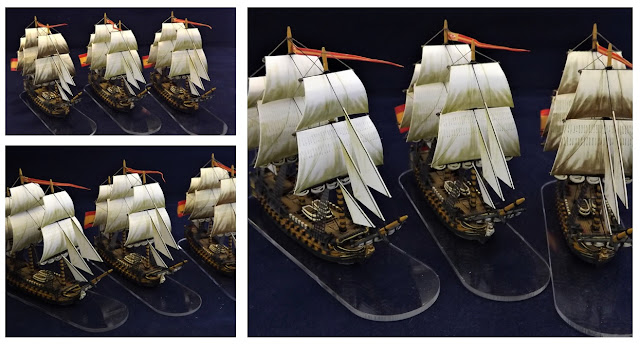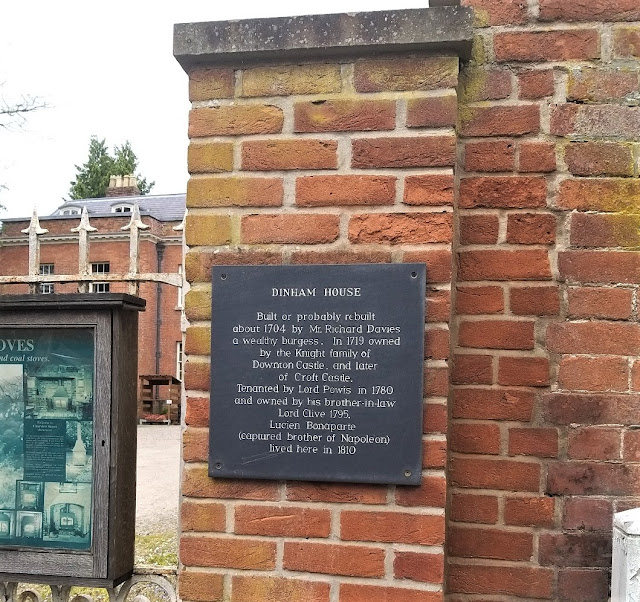Carrying on from my previous post, see link below, Carolyn and I recently enjoyed our first trip away in six months following a long long winter of lockdown restrictions, and as the visitors drove along the motorway heading south-west for the May Bank Holiday weekend, we drove in the opposite direction and based ourselves just outside of Shrewsbury to explore the delights of North Wales and the border area, which after a very enjoyable day in Anglesey saw us retrace our steps back to Ludlow, the next day, after stopping their briefly on our way up.
We were captivated by Ludlow on our first visit to the town and made plans to come back, with the first place to visit being the ruins of the castle, built by Walter de Lacey around 1075 AD, soon after the Norman Conquest, and who was given lands in Herefordshire and Shropshire, becoming one of King William's trusted Marcher Lords controlling the borders with Wales.
The castle played a key role in the civil strife of the Barons War between Empress Matilda and Stephen of Blois and in the ensuing struggles of the 12th century seeing this key fortification change hands to rival claimants and again in the Second Baron's War of the 13th century between Henry III and Simon de Montfort, seized briefly by Simon, but recaptured by Henry's supporters led by Geoffrey de Grenville, and was the base from where Prince Edward rallied his supporters in 1265 to begin his campaign against de Montfort that culminated in the Battle of Evesham later that year.
 |
| View of the outer bailey of Ludlow Castle looking from the main gate towards the inner bailey beyond. |
Geoffrey de Grenville would continue his occupation under Edward and would develop the castle by rebuilding the inner bailey, adding the Solar and Great Hall in the North Range, and linking up the castle outer wall with a town wall some time between 1250 to 1290, to form a continuous ring of defences around the town.
 |
| The Keep and Judge's Lodgings overlook the bridge over the moat into the inner bailey |
The castle passed into the hands of the powerful Marcher Lord, Roger Mortimer, 1st Earl of March with his marriage to Joan de Grenville, 2nd Baroness Grenville in 1301 who further extended the buildings and the Mortimer's would control the castle for over a century before it passed into the ownership of the Crown becoming a key Yorkist possession on the Welsh border during the Wars of the Roses.
 |
| The crest over the arch leading into the inner bailey and Judge's lodgings are of Sir Henry Sidney who was president of the Council when the new Tudor lodgings were completed in 1581 |
Ludlow and its castle would develop into the key centre of administration for Wales and the borders with it's role confirmed as the seat of the Council of Wales and the Marches, between the 15th and 17th centuries, governing the nearby lands and overseeing the courts of justice for the region and seeing a gradual renovation of its buildings for its role with luxuriously appointed buildings added to accommodate key personages when staying there.
 |
| A view of the inner bailey from the Judge's Lodgings with the round Chapel to the right foreground and the North Range beyond. |
The ruination of the castle would follow the English Civil War after its occupation by Royalist forces throughout the struggle and seeing a brief siege at the end of the war that left the castle to fall into disuse and the abolishing of the Council in 1689 with its buildings left to decay through neglect until landscaping in the 18th century and interest from the new tourist classes of the 19th century saw its restoration as a visitor attraction through to the modern day.
 |
| The round nave of the Chapel of Saint Mary of Magdalene is all that remains of the chapel built in the 1100's, with the foundations of the rest of the building visible in the grass to the right, that connected it to the wall of the Inner Bailey. |
The ruined apartment buildings around the Solar and Great Hall, hint at the former glory of these luxurious rooms with multiple fire places and walls long without their covering of plaster and drapes leaving the visitor to imagine their previous splendour.
 |
| The steps leading up to the door of the Great Hall with its stone arched windows dominate the back of the Inner Bailey. |
Moving outside and to the upper battlements reveals the former fortress that Ludlow was as a commanding fortification in the Welsh Marches befitting a Welsh Marcher Lord, with its imposing position overlooking the fast flowing River Teme.
 |
| The roar and babble of the cascading River Teme, just visible through the trees beyond the wall, echoes over the battlements. |
 |
| The castle today provides a romantic backdrop for wedding parties and other courting couples |
 |
| Sally Ports facilitate an aggressive defence from Ludlow's garrison |
 |
| The path around the back of the North Range Wall overlooking the steep cliff above the River Teme |
Of course there's more to Ludlow than its 11th century castle which was more than evident by the buildings that make up the town ranging right through British architectural history and items such as the magnificent Russian 24-pounder naval cannon, setup outside the castle's main entrance after capture at the fall of Sevastopol during the Crimean War 1853-56, and later delivered to Ludlow, one of dozens of such prizes taken and awarded to towns throughout the UK and its dominions, for their support of British forces in a very hard fought war.
Sevastopol was and is the principal Russian naval base on the Black Sea and became the main focus of Allied forces, laying siege to the city for over a year whilst struggling to isolate it from the interior.
 |
| British siege batteries bombarding Sevastopol - William Simpson |
The town was shattered by a prolonged Anglo-French cannonade, followed on the 8th September 1855 by a French assault that took the key Russian position dubbed the Malakhov redoubt.
 |
| Interior of the Redan redoubt after the fall of Sevastopol 1855 |
The simultaneous British assault on the neighbouring redoubt, the Redan, failed, but that night the Russians evacuated the south side of Sevastopol, retreating to the north, leaving the base in the hands of the Allies, with its naval base facilities, fortifications and vast quantities of stores and ordnance.
The war was ended by the Treaty of Paris, March 30th 1856.
Russian cannon captured during the Crimean War, have a special place in British military history in that the metal from such pieces was used in the creation of Britain's highest military award for valour, the Victoria Cross.
The Ludlow cannon has some interesting features that reveal an interesting back story, with the gun bearing the markers of its identity from the double headed Imperial Russian Eagle atop the barrel to the makers mark on its trunnions, with the right hand trunnion identifying it as a 24-pounder frigate gun, weighing 122.5 poods, about 1 ton or 2000kg and cast in 1799.
So it's a ship's gun probably dismounted from a warship in the harbour and incorporated into the defences of the town.
Additionally the Cyrillic letters inscribed on the left trunnion, 'ALKSND-ZVD' give information on its origin, namely the Aleksandrovskii Zavod or Alexander Foundry, in the town of Petrozavodsk, three-hundred miles north of St Petersburg.
The foundry was established in the reign of Empress Catherine II and was operational in 1774, and in 1786 an Englishman by the name of Sir Charles Gascoigne (1738 -1806), a former director of the Carron Company in Falkirk, Scotland, where the famous carronade was invented, was appointed to run it, with several other Britons employed by Catherine to help update her military as she began to modernise her empire.
The gun is clearly one of the Gascoigne pieces, identified by the letters 'D. GASKOIN' and his smooth bore guns were known to be well made and hence still in service in the Crimea despite the introduction of more modern rifled guns.
Heading into the town from the castle you are immediately aware of the history around you in the buildings and as a 'soft-southerner', I am always aware of the architectural heritage that the more northern parts of the country are blessed with, in places such as York, Chester and here in Ludlow, as soon as you get away from towns that were well within range of Hitler's Luftwaffe, that very sadly destroyed similar buildings in places like Exeter and Plymouth in my own neighbourhood, with only a few examples still surviving.
As mentioned in my previous post, there are more historical blue plaques set up on the walls of notable buildings in Ludlow than you could shake the proverbial stick at, with over five-hundred historic buildings in the town.
 |
| The 13th century Rose & Crown, serving ale for over 600 years! |
 |
| A relatively 'new-build' for Ludlow, the Feathers Hotel, built 1619 |
With all the medieval rule sets such as Baron's War and Never Mind the Billhooks being the latest fashion going through the hobby, a few building references such as Ludlow may well come in handy for recreating the odd medieval town hovel.
 |
| Broad Street and King Street timber-framed shop built circa 1404 |
Dinham House is situated close to the walls of the castle and is another major historical landmark in the town being a former residence of Lucien Bonaparte, among others, the younger brother of Napoleon who was captured by the British whilst trying to take a ship to America in 1810.
Lucien would later return to France in 1814 following his brother's abdication and a reconciliation during the 'Hundred Days' in 1815, being made a French Prince by Napoleon, but not recognised by the returning Bourbons following Waterloo, leaving him to return to Italy where he died in 1840.
 |
| The palatial Dinham House |
Given my focus on all things Napoleonic naval at the moment I couldn't help noticing the blue plaque below.
Midshipman Vashon entered the navy at the tender age of thirteen in 1755 serving aboard the 28-gun frigate HMS Revenge, rising steadily through the ranks to Post Captain and Flag rank reaching Admiral of the White and being knighted, whilst seeing service through the Seven Years War, American War of Independence, French Revolutionary and Napoleonic Wars, having an island off Washington State, USA named after him during the exploration voyages of George Vancouver, who gave his name to the Canadian city on the Pacific west coast.
Ludlow is an amazing place to visit for anyone with the slightest curiosity in British history as well as being a very attractive town which I know Carolyn and I have only scratched the surface off on our one day wondering around the town centre and castle, and a place we will no-doubt visit again if in the area.
 |
| The 13th-14th century Castle Lodge |
References referred to in this post:
https://en.wikipedia.org/wiki/Listed_buildings_in_Ludlow_(northern_area)
Next up: New additions join the French and Spanish collections of model ships with L'Orient at anchor and three more Spanish third rates ready for their photo reviews and further adventures on the North Wales border continue with a visit to the Telford Canal at Wrexham and the glorious Stokesay Castle as we began our journey home.















































































